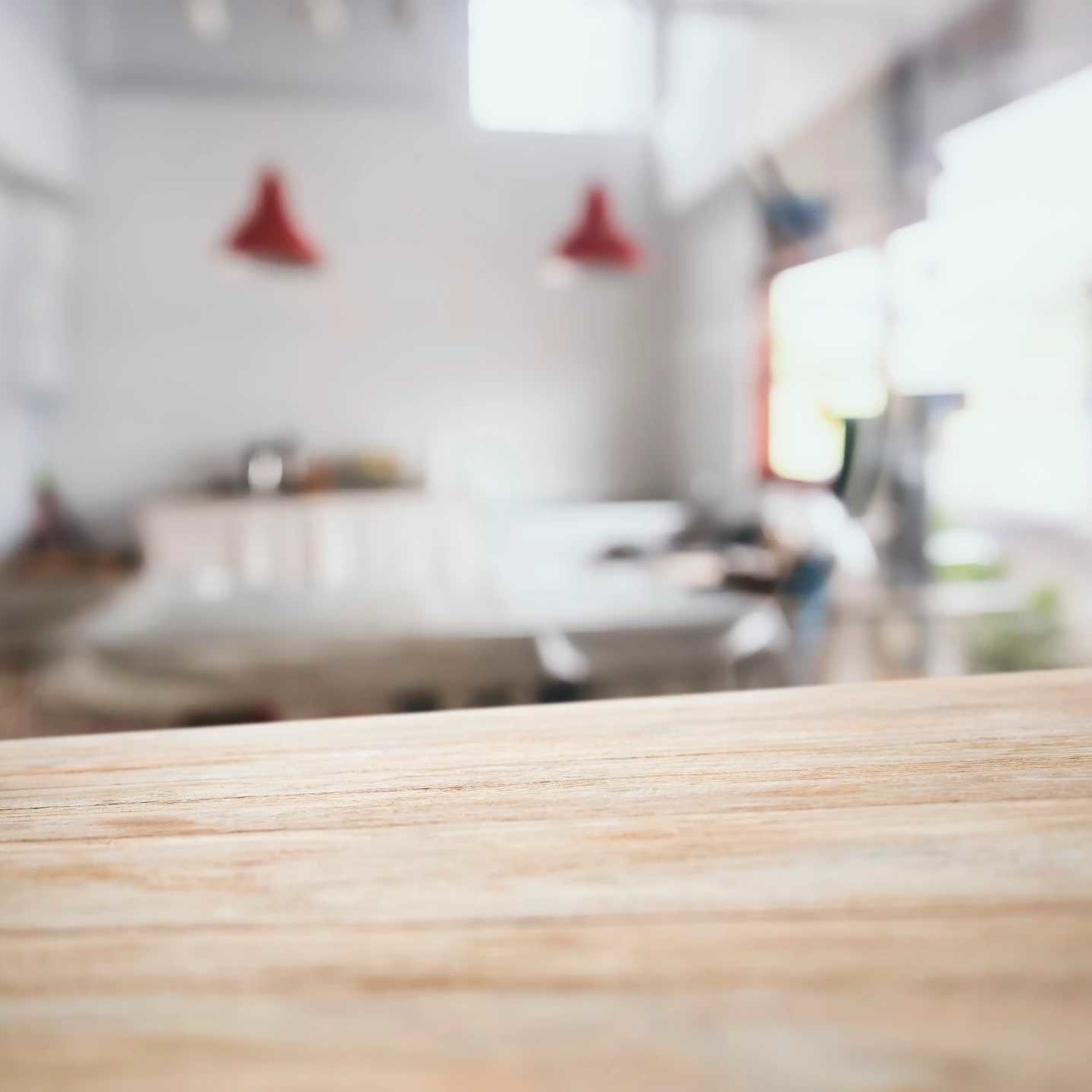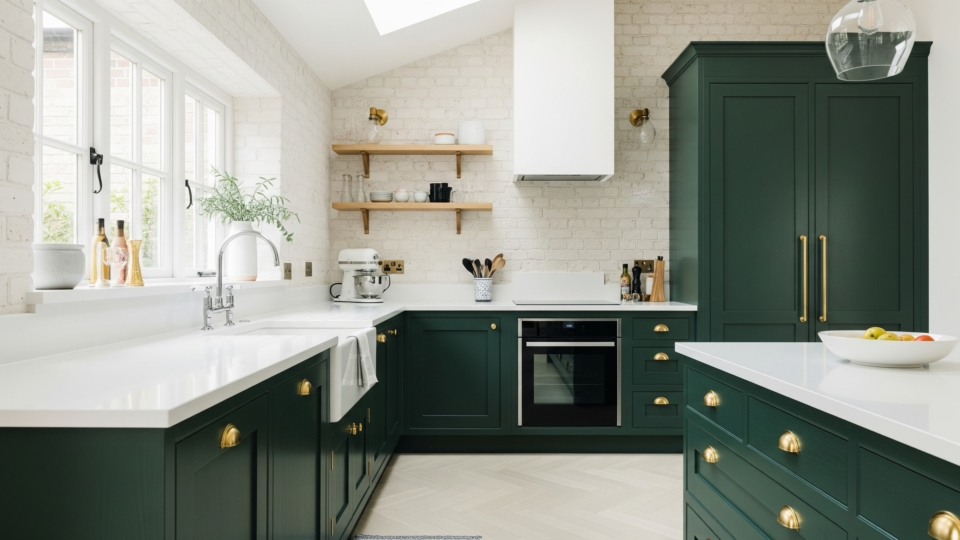
What Kitchen Remodel Trends Are Dominating in 2025?
Kitchens are evolving in 2025 like never before. No longer just utilitarian spaces, kitchens have become multi-purpose hubs for cooking, dining, working, and gathering. With over half of U.S. homeowners planning renovation projects in 2025. And kitchens topping the list of priority makeovers. It’s clear that homeowners nationwide are eager to refresh the heart of their homes. This year’s kitchen remodel trends reflect a desire for both high style and high function. From throwback design influences to cutting-edge smart tech, 2025’s dominating trends balance personal expression with practical innovation. (For a broader view of home design directions, explore our guide to the top interior design trends of 2025.) In this pillar post, we’ll break down what’s “in” for kitchens across America. And how you can incorporate these ideas into your own home.
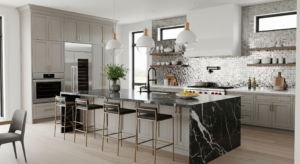
Kitchen Remodel Trends 2025 FAQs
What kitchen design styles are popular in 2025?
Transitional kitchens remain very popular, and traditional style is seeing a comeback. Many designers are also incorporating mid-century modern and other retro influences. Meanwhile, the once-dominant farmhouse style is continuing to decline as homeowners explore new looks.
Are all-white kitchens out of style in 2025?
All-white kitchens are less dominant than before. While white cabinets and countertops are still common, many homeowners now prefer adding color with earth tones or bold accents. In 2025 the trend is toward more personality and warmth, rather than a purely monochromatic white look.
How can I make my kitchen remodel eco-friendly?
Choose sustainable materials and energy-efficient fixtures. For example, use eco-friendly materials like bamboo, reclaimed wood or recycled glass for cabinets and counters. Select Energy Star-rated appliances that conserve water and electricity. Also opt for low-VOC paints and finishes. These steps will make your kitchen greener without sacrificing style.
What smart kitchen features should I consider in 2025?
Consider integrating Wi-Fi enabled, smart appliances and devices. Popular 2025 upgrades include smart refrigerators with touchscreens, ovens you can preheat with a smartphone app, voice-controlled lighting or faucets, and AI-powered coffee makers. These tech features add convenience and a high-end feel to a modern kitchen.
Are large kitchen islands still popular in 2025?
Yes. Spacious, multi-functional kitchen islands are very popular in 2025 kitchen designs. Many homeowners are adding big islands (often over 7 feet long) with extra seating, storage, and even built-in appliances. Large islands serve as a central hub for cooking, dining, and socializing.
Revival of Design Styles and Personalization
Mid-Century & Retro Influences Make a Comeback
Everything old is new again in 2025. Mid-century modern and retro styles are re-emerging as homeowners seek timeless character with a modern twist. Design elements from the 1950s and 1970s are showing up in kitchens today.
From bright, earthy 1970s color palettes to the clean lines and muted minimalism of the ’50s. Think warm wood tones, geometric backsplashes, and vintage-inspired fixtures alongside sleek cabinetry. This blend of past and present adds warmth and charm, proving that a touch of nostalgia can coexist with contemporary convenience. The mid-century modern revival, for example, embraces simple forms and functional layouts accented by pops of color or retro appliances, giving kitchens a timeless yet trendy look.
Transitional & Traditional Styles vs. Farmhouse Decline
While ultra-modern kitchens grab headlines, transitional style remains the most popular design approach for remodels. About 1 in 4 renovating homeowners opt for this mix of classic and contemporary.
However, traditional kitchens are making a notable comeback in 2025, rising to 14% of designs (up 5% from the previous year). Hallmarks of traditional kitchens – like elegant crown moldings, paneled cabinetry, and decorative lighting – are finding favor again as people crave a cozy, classic atmosphere. On the flip side, the once-ubiquitous modern farmhouse look is finally fading, now chosen by only 7% of remodelers.
As the farmhouse’s popularity wanes, other styles (from rustic cottage to sleek modern) are stepping in to fill the void. The key takeaway: homeowners are increasingly comfortable mixing styles to achieve a unique look, rather than following one “cookie-cutter” trend.
Personalized, Lived-In Aesthetics Over Minimalism
Perhaps the biggest overarching theme is personalization. In 2025, sterile showrooms are out and character is in. Homeowners want kitchens that reflect their personality and lifestyle, not just a catalog image. Designers report that clients are “jettisoning the futuristic seamless kitchen” in favor of more eclectic, crafted looks full of personal touches.
This means layered, lived-in aesthetics are winning out over overly minimalistic, all-neutral schemes. Unique collections on open shelves, family photos or art in the breakfast nook, and one-of-a-kind vintage pieces integrated into the decor all make the kitchen feel distinctly yours. Even in minimalist layouts, a personalized approach adds soul. Members of the National Kitchen and Bath Association note that “thoughtful designs that prioritize functionality with a personalized touch” are a key trend. In short, 2025’s kitchen is not a one-size-fits-all showroom – it’s a reflection of the people who use it every day.
Trending Now: According to a major industry report, 71% of design professionals say their clients want colorful, personality-filled kitchens rather than plain white spaces. The same report highlights that impersonal, matchy-matchy designs are on the way out, being replaced by more textured, character-rich looks.
Color and Material Trends in 2025 Kitchens
Bold Color Palettes Replace All-White Schemes
If you’ve grown tired of all-white kitchens, you’re not alone. The boring white kitchen is finally a thing of the past. In 2025, we’re seeing an explosion of color in the kitchen. Homeowners are embracing bolder, more expressive color palettes, from cabinets to walls to appliances. In fact, Color is leading the charge: nearly three-quarters of design experts (71%) report clients are moving beyond the white-and-gray norm and opting for colorful kitchens that reflect their personality.
These pops of color show up in creative places. Think painted island bases, two-tone upper and lower cabinets, vibrant tile backsplashes, patterned wallpaper, and even colorful ranges or refrigerators. While a full-on rainbow kitchen isn’t the goal, strategic doses of color breathe life into the space. Designers note that even a neutral kitchen can get a 2025 update by introducing an accent island or bold backsplash in a signature hue.
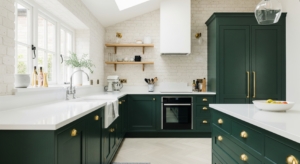
Earth Tones and Nature-Inspired Hues
Alongside bold statements, earthy and nature-inspired colors are hugely popular. Homeowners are drawing from nature’s palette to create a soothing yet stylish atmosphere. Greens are the breakout star – from soft sage to rich forest green. Bringing the outdoors in. According to the National Kitchen & Bath Association’s 2025 trend forecast, 76% of design pros say green is the top kitchen color this year, followed by navy or sky blue (63%) and warm brown (56%) tones.
This marks a clear shift away from the cool gray tones of years past toward colors that feel organic and comforting. We’re seeing cabinets in olive or hunter green, islands painted deep blue, and walls in earthy terra cotta or sandy beige. These earth tones pair beautifully with natural materials (like wood and stone) and help kitchens feel connected to the environment. Even appliance manufacturers have rolled out retro-inspired colors (think avocado green or sunset orange) to tap into this trend. It’s all about infusing warmth and life into the kitchen through color.
Mixing Metals, Textures & Finishes
2025 is not the year to play it safe with matchy-matchy materials. Instead, designers and homeowners are mixing and matching metals, finishes, and textures to create visual interest. For example, polished chrome fixtures might coexist with matte black cabinet handles and a brushed brass faucet, and it works.
A recent industry survey found that 67% of designers favor backsplash designs that blend different materials or tile patterns for a unique statement. This could mean a marble slab backsplash behind the range and hand-painted tiles elsewhere, or mixing glass tile with natural stone. Lighting fixtures are another area getting the mix-and-match treatment: over 80% of designers say statement lighting (often combining metals, glass, rattan, etc.) is a defining feature of trend-forward kitchens. The result is a layered, dynamic look that feels collected over time rather than installed all at once. Even finishes on cabinets are varied – it’s not uncommon to see a kitchen island in a different color or wood species than the perimeter cabinets, or upper cabinets in one finish and lower in another. Uniformity is out, personality is in.
To illustrate how styles are shifting, the NKBA’s report calls out a few fading trends in contrast to the new mix-and-match ethos:
- All-white and all-gray kitchens – giving way to more earthy hues like greens and browns.
- Overly minimalistic, impersonal designs – being swapped for lived-in, layered spaces with character.
- Uniform, one-note finishes – being pushed out in favor of textured materials and bolder color contrasts.
In short, don’t be afraid to mix different textures and metal tones in your kitchen remodel. Combining, say, a brass pendant light with stainless steel appliances and a black matte faucet can make the space feel curated and sophisticated. The trick is to choose a unifying element (like a common color family or style theme) so the combinations feel intentional.
Sustainable Materials and Eco-Friendly Finishes
Eco-conscious design continues to gain momentum. Sustainable materials are taking center stage in 2025 kitchen remodels as homeowners seek to reduce their environmental footprint and have a gorgeous space. Expect to see eco-friendly materials like bamboo, reclaimed wood, recycled glass, and cork used creatively in kitchens. These materials add unique texture and story – for example, cabinetry crafted from reclaimed barn wood brings history into a modern home, and recycled glass countertops can mimic terrazzo for a fun, eco-friendly surface. Low-VOC paints and finishes are also a must for health and sustainability. The push for green kitchens isn’t just anecdotal: industry data shows sustainability is a top priority for homeowners in 2025, with recycled and upcycled materials gaining popularity for their eco appeal and one-of-a-kind look.
Countertops and flooring offer great opportunities to go green without sacrificing style. Many renovators are opting for recycled composite countertops or selecting natural stones from companies that practice sustainable quarrying. Even ultra-durable paper composite counters (made from compressed recycled paper and resin) are appearing in stylish kitchens. On floors, rapidly renewable materials like cork or bamboo provide warmth underfoot and environmental peace of mind. These choices prove that going green can be both chic and practical. In addition, choosing quality, durable materials that “age gracefully”. Such as real wood, stone, or patina metals – aligns with sustainable principles, since these elements will last for decades (and develop character over time) instead of ending up in a landfill.
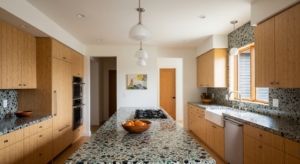
Functional Layouts and Features
Concealed Kitchens & Integrated Appliances
One striking trend in 2025 is the disappearing kitchen – or at least, a kitchen that doesn’t announce itself. Designers are increasingly creating concealed kitchens where appliances and even whole prep areas can be hidden behind cabinetry for a seamless look. Panel-ready refrigerators and dishwashers that blend into cabinet fronts have become standard in high-end remodels.
Now, innovations like retractable doors can hide away your entire kitchen counter or a secondary “work kitchen” when not in use. Even range hoods are going incognito: instead of a bulky metal hood, homeowners are opting for sleek vent inserts tucked into the ceiling or cabinetry. The goal is a cleaner, uncluttered aesthetic – the kitchen can visually merge with living spaces in open-plan homes without always looking like a kitchen.
This trend is perfect for those who love minimalist design or entertain frequently. When the kitchen is tidy and subtly integrated, it allows other design elements (like art, furniture, or architectural details) to shine. As one interior architect noted, hiding functional elements makes the kitchen “appear more like a sophisticated piece of millwork”.
It’s form and function: your kitchen works just as hard, but it doesn’t have to look utilitarian 24/7. Expect to see more flush-mount cooktops, handle-less cabinets, and pocket doors that tuck away countertops or coffee stations. This polished backdrop lets homeowners focus on fun design touches in the foreground – a pop of color, an eye-catching texture, or decorative accessories – without visual clutter.
Multipurpose Islands and Expanded Pantries
The kitchen island has solidified its status as the command center of the kitchen. And it’s bigger and more functional than ever. More than half of homeowners who remodel either add a new island or upgrade an existing one, and a significant share (52%) are building islands over 7 feet long.
These large islands serve multiple purposes: food prep station, dining table, homework desk, and party buffet all in one. In 2025, the multipurpose kitchen island often comes equipped with extras like a prep sink, built-in cooktop, wine fridge, or plentiful storage cabinet. It truly becomes a hub for both working and socializing. Designers are also getting creative with island shapes. While rectangular islands still dominate, some homeowners are adding L-shaped or curved extensions to maximize seating and surface area.
Along with sprawling islands, pantry spaces are growing. Walk-in pantries, butler’s pantries, or pantry cabinets with floor-to-ceiling storage are must-haves in high-end kitchen remodels. With the recent focus on stocking up on staples (and the rise of bulk grocery buying), people want a place to store all that food and kitchen gear out of sight. A well-designed pantry or auxiliary storage room keeps the main kitchen from feeling cluttered, allowing that clean, open look that’s so popular. In luxury homes, you may even find a second kitchen or scullery hidden behind the main kitchen. A space to do messy prep or house small appliances (like the toaster, coffee maker, or microwave) so the primary kitchen stays pristine. Even if you’re working with a smaller footprint, dedicating a cabinet bank or closet as a pantry can significantly enhance your kitchen’s functionality.
For those opening up their kitchens by removing formal dining rooms (a common move, as 35% of homeowners increase the kitchen’s footprint by borrowing adjacent space), an island with ample seating or a built-in breakfast nook becomes essential. It ensures you don’t lose dining functionality while gaining that open flow.
Lighting as a Focal Point (for Work & Entertaining)
Kitchen lighting is no longer an afterthought – it’s a design feature in its own right. In 2025, statement lighting fixtures are a top trend for adding personality and functionality to kitchens. Think grand pendant lights over the island, a sculptural chandelier above the dining table, or rows of stylish LED sconces under cabinets. With open floor plans remaining popular, the kitchen is often on display, and eye-catching lighting helps define the space and create ambiance. Moreover, as one designer aptly put it, “To work, you need to see”. Meaning that beyond looks, a well-lit kitchen is crucial for cooking and tasks.
Expect to see a mix of skylights, under-cabinet LEDs, and decorative pendants all layered in one kitchen. Natural light is being maximized with larger windows and even foldable glass walls to blur indoor-outdoor boundaries (bringing in more daylight and views). For evenings, adjustable LED systems can shift the kitchen from a bright workspace to a cozy entertaining area with the push of a button. Many homeowners are installing smart lighting that can dim or change color temperature to suit the mood (cool bright light for meal prep, warm ambient light for dinner parties).
The fixtures themselves often double as art. In a boldly designed 2025 kitchen, you might find oversized rattan pendant lights to accent a boho-chic theme, or ultra-modern linear chandeliers in a sleek city kitchen. Mixing materials is common here too – a fixture might combine wood, metal, and fabric, for example. Tying into the mix-and-match material trend. The bottom line: don’t skimp on lighting design in your remodel. It’s one of the easiest ways to make a style statement and improve your kitchen’s usability.
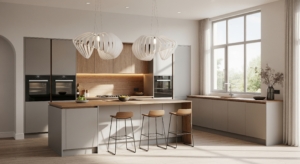
Smart Technology and Innovation
Smart Appliances and Connected Kitchens
The “smart kitchen” has moved from futuristic concept to mainstream reality in 2025. Integrating smart technology into kitchen design is now a dominant trend, as homeowners look for ways to make their kitchens more convenient, efficient, and fun. What does a smart kitchen remodel include?
Common upgrades are Wi-Fi enabled appliances. Refrigerators that can tell you if you’re low on milk via a smartphone app, ovens you can preheat from your phone or by voice command, and dishwashers that self-diagnose maintenance issues. Voice assistants (Alexa, Google Assistant, etc.) are also becoming kitchen staples, allowing you to adjust lighting, play music, or set a timer with a hands-free command.
In 2025, many kitchen appliances are designed with smart features as standard. You’ll see touchscreens on refrigerator doors for family calendars and grocery lists, smart faucets that dispense exact amounts of water at set temperatures, and even AI-powered cooking gadgets that can perfectly cook a steak or brew espresso with minimal input. These innovations aren’t just gimmicks. They meaningfully improve daily life by saving time and reducing guesswork in the kitchen. Importantly, manufacturers are focusing on inter-connectivity: the ability for devices to communicate with each other.
For instance, your oven might alert your phone (or smartwatch) when it’s preheated or dinner is done. Or your smart speaker could announce that the wash cycle is complete. Such connectivity turns the kitchen into a cohesive, intelligent ecosystem.
When remodeling, integrating smart tech can be as simple as choosing appliances that offer the features you value. Many homeowners start with a smart fridge or range, then add gadgets like smart plugs (to voice-control the coffee maker) or retrofit older devices with smart switches. It’s wise to ensure you have robust Wi-Fi coverage in the kitchen, since all these devices depend on it. While it may sound high-tech, the goal is actually to simplify tasks – kitchens of the future handle more of the work, so you can enjoy cooking and entertaining with less hassle.
Energy-Efficient, Eco-Conscious Appliances
Hand-in-hand with smart tech is a push for energy efficiency and eco-friendly appliances. Many 2025 kitchen remodels involve upgrading to appliances that not only have modern features but also use less water and electricity. Homeowners are keen on reducing utility bills and environmental impact without sacrificing performance.
The good news is that today’s high-efficiency refrigerators, dishwashers, and ovens often outperform older, less efficient models. Look for Energy Star-rated appliances as a baseline – these meet strict efficiency criteria set by the EPA.
Induction cooktops are one example of a trending appliance choice that’s both tech-forward and energy-smart. Induction technology uses magnetic fields to directly heat cookware, offering precise temperature control and faster boil times than traditional gas or electric, all while wasting less heat (and it eliminates open flames for a safer, cleaner kitchen). Similarly, modern dishwashers and refrigerators have inverter compressors and smart sensors to adapt their operation and minimize energy use. There’s also a surge in interest for appliances with eco modes or those made with sustainable materials (some brands tout recycled insulation or lower-impact manufacturing).
Going green extends beyond the big appliances. Smaller changes like LED lighting (for under-cabinet lights or inside the fridge), low-flow kitchen faucets, and even smart plugs that cut power to devices in standby mode all contribute to an eco-friendlier kitchen. Homeowners are increasingly viewing these choices as part of the overall design vision – an efficient, sustainable kitchen is a selling point and a source of pride. By combining smart controls with energy-efficient engineering, 2025’s kitchen gadgets manage to be cutting-edge and conscientious at the same time.
Conclusion
The kitchen remodel trends dominating 2025 showcase a dynamic blend of innovation and inspiration. We’re seeing homeowners color outside the lines of yesterday’s designs – embracing vibrant hues, mixed materials, and personalized touches that make the kitchen truly the heart of the home. At the same time, functionality is front and center: layouts are becoming smarter (and sometimes larger), appliances more advanced, and materials more sustainable. The best 2025 kitchens marry form and function, delivering on style (with bold aesthetics and nods to retro charm) while making daily life easier (through concealed storage solutions and intelligent tech).
Remember, the ultimate kitchen trend is designing a space that fits your lifestyle. Not every fad will suit every home – and that’s okay. Use these 2025 trends as inspiration to inform your choices, whether you’re repainting your cabinets in a fresh new color, upgrading to a smart fridge, or planning a full gut renovation. The goal is a kitchen that feels up-to-date yet timeless, and above all, truly yours. By blending some of these dominating trends with your own personal taste, you can create a kitchen that will be a joy to cook in, gather in, and love for years to come.
If you’re looking to bring more sensory depth into your remodel, consider the role of fabrics and finishes. Our recent blog, How to Combine Texture and Tranquility in 2025 Explores how layered textiles, natural materials, and calming palettes can transform a kitchen into a space that not only looks beautiful but also feels inviting and restorative.
(Considering a kitchen makeover? Stay tuned to Sains Interiors for more design-savvy tips, or consult with a professional designer to bring your dream kitchen to life.)
